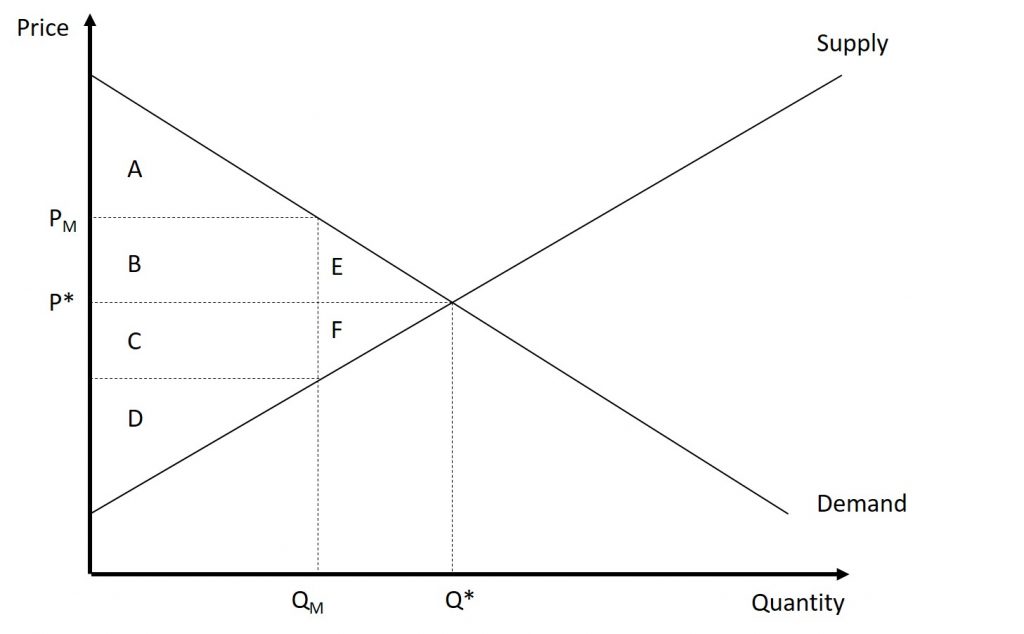5 Consumer Choice
5.1 consumption choices
Review Activities
Problems
Problem 5.1.1: Complete the following utility table:
| Quantity | Total Utility | Marginal Utility |
| 0 | 0 | XX |
| 1 | 200 | |
| 2 | 150 | |
| 3 | ||
| 4 | 420 | 20 |
Answer: 200; 350; 400, 50
Problem 5.1.2: Jeremy is deeply in love with Jasmine. Jasmine lives where cell phone coverage is poor, so he can either call her at a rate of $1 per phone call or he can drive to see her, at a round-trip cost of $2 in gasoline money. He has a total of $10 per week to spend on staying in touch. To make his preferred choice, Jeremy uses a handy utilimometer that measures his total utility from personal visits and from phone minutes. The utility is given below. Determine the utility maximizing consumption bundle.
| Calls | Utility | Trips | Utility |
| 0 | 0 | 0 | 0 |
| 1 | 80 | 1 | 200 |
| 2 | 150 | 2 | 380 |
| 3 | 210 | 3 | 540 |
| 4 | 260 | 4 | 680 |
| 5 | 300 | 5 | 800 |
| 6 | 330 | 6 | 900 |
| 7 | 200 | 7 | 980 |
| 8 | 180 | 8 | 1040 |
| 9 | 160 | 9 | 1080 |
| 10 | 140 | 10 | 1100 |
Answer: 2 calls, 4 trips
Problem 5.1.3: Bob has the ability to spend his $100 on widgets and wizzos. A widget costs $10 and a wizzo costs $20. Below is the utility derived from different levels of consumption. Determine the utility maximizing consumption bundle.
| Widgets | Utility | Wizzos | Utility |
| 0 | 0 | 0 | 0 |
| 1 | 200 | 1 | 80 |
| 2 | 350 | 2 | 150 |
| 3 | 480 | 3 | 210 |
| 4 | 580 | 4 | 260 |
| 5 | 660 | 5 | 300 |
| 6 | 720 | 6 | 330 |
| 7 | 770 | 7 | 350 |
| 8 | 810 | 8 | 360 |
| 9 | 830 | 9 | 365 |
| 10 | 840 | 10 | 366 |
Answer: 8 widgets, 1 wizzo
External Resources
Khan Academy: Marginal Utility and Total Utility
Khan Academy: Marginal Utility and Total Utility Graphically
Utility Maximization: Equalizing Marginal Cost per Dollar
5.2 consumer behavior in markets
Review Activities
Problems
Problem 5.2.1: Jean wishes to purchase a new washing machine. His maximum willingness-to-pay for this specific model is $300. Calculate the consumer surplus in the following situations, if applicable:
- When Jean arrives at the store the machine costs $300.
- When Jean arrives at the store the machine is on sale for $250.
- When Jean arrives at the store the machine now costs $360.
Answers: $0; $50; No transaction
Problem 5.2.2: It costs a company $1,000 to produce a widget. They decide this is the least they are willing to charge for the widget. Calculate the producer surplus in the following situations, if applicable:
- The consumer is willing to pay $850 for the widget.
- The consumer is willing to pay $1,000 for the widget.
- The consumer is willing to pay $1,200 for the widget.
Answers: No transaction; $0; $200
Problem 5.2.3: A consumer is willing to spend $18,000 on a specific model of a new car. It costs the car manufacturer $13,000 to produce it which is also the least they are willing to take for it. Calculate the consumer surplus, producer surplus, and total welfare at the following prices, if applicable.
- $12,000
- $14,000
- $17,000
- $20,000
Answers: No transaction; CS=$4,000, PS=$1,000, TW=$5,000; CS=$1,000, PS=$4,000, TW=$5,000; No transaction
Problem 5.2.4: Consider the figure below:

- When the market is in its initial equilibrium, find the following: consumer surplus, producer surplus, total welfare, and deadweight loss (if applicable.)
- Once the market is taken over by a monopolist, find the following: consumer surplus, producer surplus, total welfare, and deadweight loss (if applicable.)
Answers: CS=A+B+E, PS=C+D+F, DWL=0; CS=A, PS=B+C+D; DWL=E+F (Note: There is an error in the video. The answers listed here are correct.)
External Resources
Khan Academy: Consumer Surplus Introduction
Khan Academy: Consumer Surplus as Area
Khan Academy: Producer Surplus
Khan Academy: Equilibrium and Efficiency
Khan Academy: Rent Control and Deadweight Loss
Khan Academy: Price Controls and Surplus

